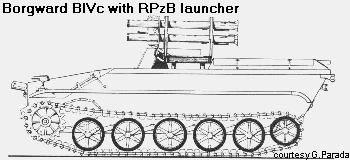

E-5 Wanze Ausf m RPzB 54
The German Army's weapon's bureau had a series of projected future tank designs, the so-called E-types (E = Entwicklung "development"), wherein the E-number roughly corresponded with the weight class of the vehicle. The smallest such design in the 5-ton class was the E-5 mini tank. The requirements called for a fast minitank, to be used in the antitank role and as machine gun carrier, with no more than 6 - 10 tons of weight and one or two crewmen. The projected minitank was given the name Wanze ("bedbug"). Several different concepts were proposed by the companies Daimler, Steyr, Büssing, Weserhütte; a model by BMW was even built in one prototype, the vehicle had a length of 3,55m and had a 90 hp engine. However, no final decision was made until March 1945, when the whole projected models all were rejected by the Inspector General of Tanks.
Panzerjäger Borgward B IVc Ausf m RPzB 54
However, there are reports of a few similar vehicles actually built and used in the defense of Berlin, the vehicle in question was the Borgward B IV Ausführung mit Raketenpanzerbüchse 54 (Borgward as the company's name; "version with rocket tank rifle").
The company Borgward had been building the B-series "Minenräumwagen" ("mineclearing vehicles") load carriers. The later vehicles in the series were supposed to carry a demolition charge into the minefield. This resulted in the B-IV, which was ordered by the Heereswaffenamt under the designation schwerer Ladungsträger ("heavy charge carrier").
It was operated by remote control; on the front it carried a detachable explosive charge of 500kg which it placed in the minefield that was supposed to be cleared. The original version Borgward B IVa from as early as October 1940 weighed 3.45t, had a length of 3.65m, a width of 1.80m and a height of 1.185m and was powered by a Borgward engine with 49hp. The internal fuel capacity of 130l allowed for an operating range of around 120km cross-country. Instead of the remote control it could alternately be operated conventionally by a driver; armor plating to the front and sides had a strength of 10mm. Original contract cost was 28,000 RM apiece. The Borgward vehicles in general didn't prove to be as widespread as their smaller brethren, the Goliath remote-controlled tracked explosive charge vehicles.
In April 1942 the first 15 vehicles were handed over to the Waffenamt; a last major production batch of the original A-version was delivered in June 1943. After that, the successor version B-Ausführung ("B-version") had stronger armor plating which increased weight to almost 4t, and 260 were produced until November 1943. The final production version was the B IVc model. Dimensions were 4.10m length, 1.83, width and 1.25m height, it had a 6-cyl. Borwgard engine of 3.75l which had a performance of 78hp which gave the vehicle a maximum speed of 40km/h. Armor thickness had been increased to 20mm at front and sides which increased the total weight to roughly 5t; 305 were produced.
A few of these in an improvisation were modified as Panzerjäger ("tank hunters"); they were armed with a sixfold RPzB.54 arrangement offset to the left side of the vehicle (the driver compartment was offset to the right in all Borgward IV vehicles); the launcher was rotatable and offered a protective shield. It was intended to engage enemy armor at short distance in a shotgun-like manner with the six Panzerschreck tubes. A few of these saw actual combat in the defence of Berlin in the closing days of the war.